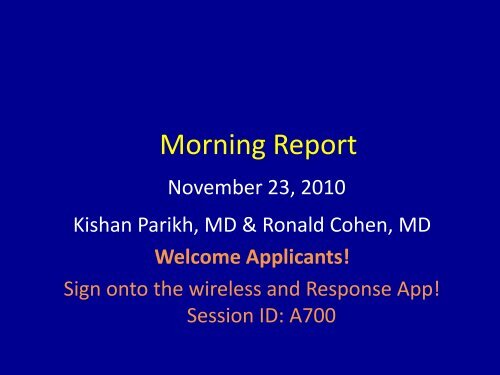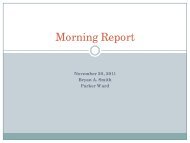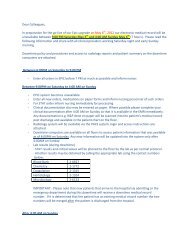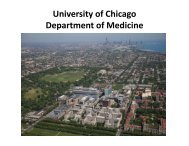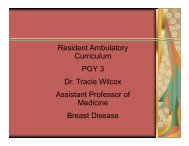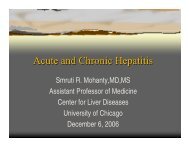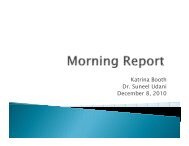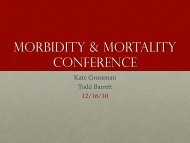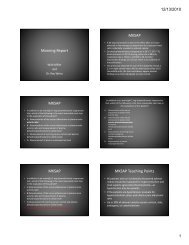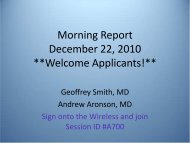Morning Report
Morning Report
Morning Report
Create successful ePaper yourself
Turn your PDF publications into a flip-book with our unique Google optimized e-Paper software.
<strong>Morning</strong> <strong>Report</strong><br />
November 23, 2010<br />
Kishan Parikh, MD & Ronald Cohen, MD<br />
Welcome Applicants!<br />
Sign onto the wireless and Response App!<br />
Session ID: A700
MKSAP<br />
A 72-year-old man comes to the office for a follow-up<br />
evaluation. He has had type 2 diabetes mellitus for<br />
13 years. Over the past 5 years, his hemoglobin A1c value has slowly risen to 9.8%, and his fasting blood<br />
glucose levels at home have frequently exceeded 180<br />
mg/dL (10.0 mmol/L). He has been adherent to<br />
recommended lifestyle changes. The patient is<br />
currently on metformin, 1000 mg twice daily, and<br />
extended-release glipizide, 20 mg/d. He has<br />
hypertension treated with candesartan and<br />
hydrochlorothiazide and hyperlipidemia treated with<br />
atorvastatin.<br />
• Results of physical examination are normal.
Which of the following is the best<br />
A. Add exenatide<br />
next step in therapy?<br />
B. Add insulin glargine<br />
C. Add pioglitazone<br />
D. Add sitagliptin<br />
E. Double his dosage of glipizide
Which of the following is the best<br />
A. Add exenatide<br />
next step in therapy?<br />
B. Add insulin glargine<br />
C. Add pioglitazone<br />
D. Add sitagliptin<br />
E. Double his dosage<br />
of glipizide<br />
20% 20% 20% 20% 20%<br />
A. B. C. D. E.
• This patient has poor glycemic control, despite combination therapy with metformin<br />
and extended-release glipizide (a sulfonylurea), and thus requires insulin. The<br />
standard method of initiating insulin therapy is to begin with a single daily injection of<br />
a basal insulin, such as insulin glargine, insulin detemir, or neutral protamine Hagedorn<br />
(NPH) insulin; this approach minimizes the risk of hypoglycemia. Starting doses in the<br />
0.2 to 0.3 U/kg range will be well tolerated in most patients, with future titration based<br />
on the results of home glucose monitoring.<br />
• Dose changes are typically made in increments of 2 to 4 units every few days or weekly<br />
until the fasting glucose level is consistently in the range of 70 to 130 mg/dL (3.9 to 7.2<br />
mmol/L). The addition of insulin glargine or insulin detemir to this patient’s regimen<br />
should result in a substantial reduction in his hemoglobin A1c value.<br />
• Randomized studies of stepped therapy in type 2 diabetes showed that most patients<br />
were able to achieve target hemoglobin A1c goals of 7% using a combination of oral<br />
antihyperglycemic agents and basal insulin therapy. If such a reduction is not achieved<br />
and postprandial hyperglycemia occurs, the addition of a mealtime rapid-acting insulin<br />
analogue or the substitution of a premixed insulin should be recommended.<br />
• Adding the injectable agent exenatide or another oral agent to this patient’s medication<br />
regimen is unlikely to reduce his hemoglobin A1c value sufficiently. When added to a<br />
combination oral regimen, exenatide has been shown to reduce hemoglobin A1c values by only 1% and the oral agents pioglitazone and sitagliptin by 1% or less.<br />
• In most studies of patients with diabetes, increasing the sulfonylurea dosage beyond<br />
the half maximal dosage has resulted in little to no improvement in glycemic control.<br />
Therefore, doubling this patient’s dosage of glipizide is unlikely to be effective.
Chief Complaint<br />
• 18 year old female presents with concern over<br />
no menstrual periods
HPI<br />
• Only 2 menses in lifetime both at age 15, each lasted a week<br />
• Not sexually active<br />
• Doing well in school, no fatigue or headaches<br />
• Noticed pubic hair/breast development at age 14<br />
• No acne problems, no weight gain<br />
• Denies weight self-consciousness<br />
• No hx of strenuous emotional or physical activities<br />
• No galactorrhea
PMHx<br />
• Scoliosis<br />
PSHx<br />
• None<br />
FamHx<br />
• Paternal aunt had thyroid<br />
cancer and thyroidectomy;<br />
also myasthenia gravis<br />
• Paternal GM and GGM had<br />
thyroid dysfunction<br />
• No hx of abnormal menses<br />
Meds<br />
• None<br />
Allergies<br />
• NKA<br />
SocHx<br />
• High school<br />
• Occasional cigarette and EtOH<br />
• No other drugs<br />
• No sexual activity
Differential?
Amenorrhea: Historical Clues<br />
Master-Hunter T, Helman D. Amenorrhea: evaluation and treatment. Am Fam Physician. 2006 Apr 15;73(8):1374-
Amenorrhea: Physical Exam<br />
Findings
Physical Exam<br />
Vitals: Ht 5’5” | Wt 60kg | RR 14 | P 72 | BP 110/62<br />
Gen: NAD<br />
HEENT: symmetrically enlarged thyroid w/o discrete nodules, no neck<br />
webbing<br />
RESP: CTAB<br />
CV: rrr, nl s1 s2 and no murmurs<br />
BREAST: Tanner III development. No nipple discharge.<br />
ABD: soft, nt/nd +BS<br />
LYMPH: no LAD<br />
SKIN: no acne, no hirsutism. no hyperpigmentation.<br />
No axillary or pubic hair (Brazilian bikini wax)<br />
GU: vaginal canal patent, nl cervical and vaginal mucosa. On bimanual exam,<br />
uterus palpated, no adnexal masses
What labs do you want to order?<br />
• Which labs/studies do you order first?<br />
• How do you work up secondary amenorrhea?
Assuming the pregnancy test is<br />
negative, what are the next lab tests<br />
A. Prolactin and TSH<br />
B. FSH/LH<br />
C. Estradiol and<br />
Progesterone<br />
D. FSH/LH, estradiol<br />
and progesterone<br />
E. All of the above<br />
to order?<br />
20% 20% 20% 20% 20%<br />
A. B. C. D. E.
Hypogonadism?<br />
Obstruction?<br />
Hypo/hypergonadotropic d/o?<br />
Pregnancy Test<br />
Thyroid dx or prolactinoma<br />
Master-Hunter T, Helman D. Amenorrhea: evaluation and<br />
treatment. Am Fam Physician. 2006 Apr 15;73(8):1374-82.
142 102 11<br />
4.1<br />
5.6<br />
26<br />
11.9<br />
292<br />
0.7<br />
100<br />
8.8<br />
Urine preg neg<br />
7.7 4.7<br />
0.3<br />
TSH 61.14<br />
T4 4.5 (5.0-11.6)<br />
FT4 0.53 (0.9-1.7)<br />
FTI 4.4 (6-10.5)<br />
PRL 7.5 (
How do you work up<br />
hypothyroidism?
Please make your selection...<br />
A. Thyrotropin<br />
receptor antibodies<br />
B. Anti-TPO and Antithyroglobulin<br />
C. 24 hour radioiodine<br />
uptake and scan<br />
D. Both A and B<br />
E. All of the above<br />
20% 20% 20% 20% 20%<br />
A. B. C. D. E.
• Thyroglobulin ab 40<br />
• TPO 1280
Hashimoto’s Thyroiditis<br />
• Most common cause of<br />
hypothyroidism if iodine replete<br />
• Goitrous vs atrophic (10%, may be<br />
end-stage)<br />
• Ab’s to Tg (20-50% sens) & TPO (90%)<br />
• RAIU variable (vs. painful subacute)<br />
• RR for progression to follicular<br />
lymphoma <br />
– Although absolute risk is small<br />
Pearce E.N., Farwell A.P., Braverman<br />
L.E.N Engl J Med 2003; 348:2646 – 2655<br />
Chistiakov Journal of<br />
Autoimmune Diseases 2005 2:1
Additional Workup<br />
10/19; 10/29 Normal range<br />
Estradiol 52 30-400 pg/mL<br />
Progesterone 0.5 ≤ 27 ng/mL<br />
LH 25; 12.6 ≤ 85 mIU/mL<br />
FSH 73. 0; 32.2 ≤ 19 mIU/mL
Any imaging?
• Pelvic u/s:<br />
– Endometrial stripe 0.39cm<br />
– R ovary 2.6 x 1.6 x 1.9cm, normal appearing<br />
– L ovary 2 x 1.6 x 0.9cm, normal appearing<br />
• Thyroid u/s:<br />
– Heterogenous, enlarged<br />
– Very small L lobule nodules too small for biopsy
Premature Ovarian Failure<br />
• AKA Primary Ovarian Insufficiency<br />
• Mean age of menopause is 50±4yo<br />
– ‘Premature’ if less than 40yo, amenorrhea ≥ 4 mths &<br />
menopausal-range FSH<br />
• Biopsy not helpful<br />
Turner syndrome<br />
Fragile X syndrome<br />
Chemotherapy<br />
Radiation<br />
Cigarette smoke<br />
Follicle Depletion Follicle Dysfunction<br />
FSH, LH<br />
receptor<br />
mutations<br />
Autoimmunity
How to link premature ovarian<br />
failure with Hashimoto’s<br />
thyroiditis?
Premature Ovarian Failure<br />
• 90% of cases are idiopathic, but some can be<br />
associated with syndromes<br />
• Hashimoto’s is present in 14-27% of women<br />
with premature ovarian failure<br />
– Points strongly towards an autoimmune etiology<br />
Nelson. Primary Ovarian Insufficiency. N Engl J Med 2009;360:606-14.
Nelson. Primary Ovarian Insufficiency. N Engl J Med 2009;360:606-14.
Polyglandular Autoimmune Syndrome<br />
• Type 2 (more prevalent): Ab to steroidogenic<br />
enzymes (e.g. 21-OH).<br />
– Adrenal insufficiency (100%)<br />
– gonadal failure (5-50%)<br />
– thyroid dz (70%)<br />
– DM I (50%)
How do you work this up?
Predicting DM 1: GAD65 ab<br />
© 2010 UpToDate, Inc.
Adrenal Ab < 1<br />
GAD65 ab 0<br />
Karytoype normal<br />
Additional Workup<br />
ACTH Cortisol<br />
9.5 8.9<br />
30min post 25.4<br />
1hr post 30.3
• Emotional health<br />
• HRT<br />
• Bone health<br />
• Family planning<br />
Now What?<br />
– Unlike menopause, 5-10% women will still<br />
conceive after the diagnosis is given
Teaching points<br />
• Understand the work up of secondary<br />
amenorrhea<br />
• Learn the interpretation of thyroid function<br />
tests<br />
• Understand the role of autoimmunity in<br />
primary ovarian insufficiency<br />
• Anticipate the clinical implications for primary<br />
ovarian insufficiency for women’s health


